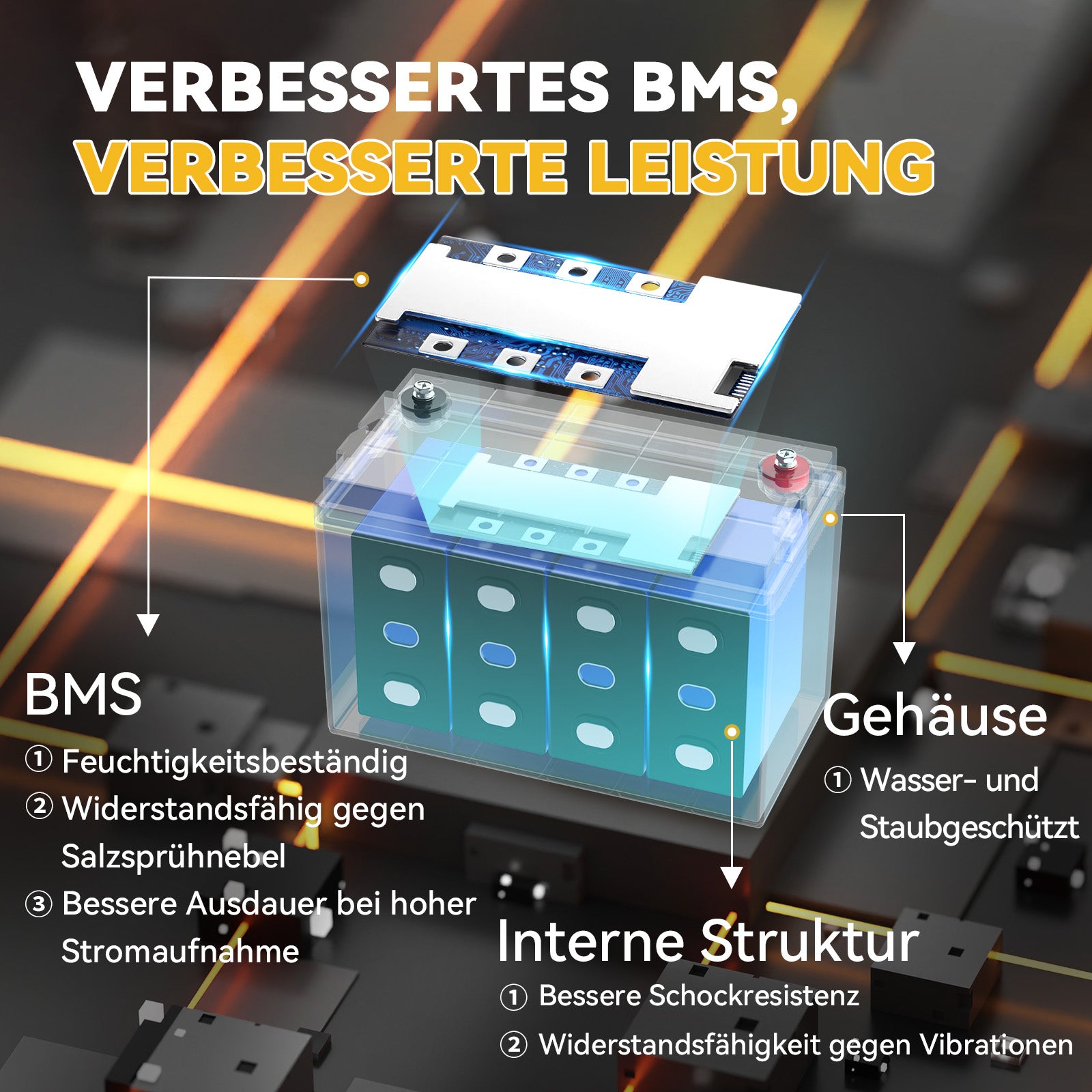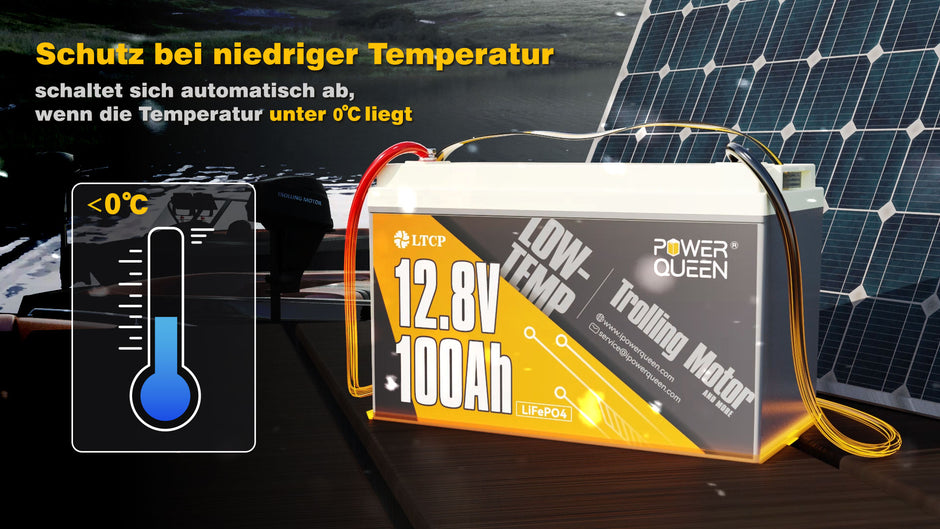
Motorhome/ship Lithium battery does not load? Read to solve!
, From Sally Zhuang, 8 min reading time
Power Queen Energy for every generation - with sustainable and clean energy solutions create a better future for all families. Whether you supply your grandparents 'slow electric car, your parents' fishing boat, your motorhome or your children's electric scooters - we take care of the energy needs of each family member.
Show more >Contact us – your satisfaction is our motivation! Our dedicated team is happy to answer any questions, provide product information, or provide technical support and looks forward to hearing from you. Customer Service: service.de@ipowerqueen.com
Show more >Power Queen not only offers high-quality lithium batteries, but also a living community. Do not miss any news, special offers and tips for using our products. Become part of the Power Queen family and benefit from inspiring content and direct interaction with our team.
Show more >The stories of our customers have helped Power Queen to grow enormous growth and strength. We work with various customers to bring sustainable energy to every house and to master the challenges of energy supply in difficult environments. Their stories started when they met Power Queen ...
Show more >On this page you will find valuable insights from other users who help you make the right decision. We hope that you will take part in the evaluation and help us to improve our commitment to excellence with your feedback!
Show more >In our battery science area, we offer you exciting insights and well-founded information about lithium batteries. Learn more about innovative applications and tips for the optimal use of your batteries. Our goal is to convey the necessary knowledge to you so that you can fully exploit the advantages of our products.
Show more >Users report on their experiences and test results from practice and give them an insight into the performance and reliability of our lithium batteries. Find out how our batteries are used in everyday life and convince yourself of your quality and efficiency.
Show more >In our shopping guide, we help you to understand the differences between our different battery models and make the best choice for your needs. You are well informed with our detailed comparisons and expert recommendations.
Show more >In this area we present exciting feedback and experiences of users who have used our lithium batteries for their DIY electricity projects. Find out how customers implemented your individual projects after the purchase and what advantages you have gained through the use of our batteries.
Show more >A life full of energy: influencers report! Find out how these creative influencers use our lithium batteries to support their adventures, be it when traveling, camping or creative projects. Let yourself be infected by your innovative ideas and passion for sustainable energy.
Show more >
, From Sally Zhuang, 8 min reading time
Lithium batteries are extremely popular due to their superior energy density and longer lifespan. However, dealing with charging issues can be quite frustrating and inconvenient. The goal of this article is to highlight the typical causes of lithium battery charging problems, provide troubleshooting advice, and present best practices for preventing such issues from occurring.
When charging lithium batteries, it is important to follow the correct charging algorithm. The process includes several steps to ensure safe and efficient charging:

It's important to use a charger specifically designed for lithium-ion or lithium-polymer batteries. Using an incompatible charger can cause damage and even pose a fire hazard. Following these guidelines will help ensure the safe and effective charging of lithium batteries.
When a lithium battery fails to charge, it's important to consider several possible causes. These range from issues directly related to the battery itself, such as damage or age, to external factors unrelated to the battery. Some investigation and troubleshooting may be necessary to determine the specific cause and find a solution.
Most lithium batteries are equipped with a BMS (battery management system) Equipped with a battery protection circuit that can protect the battery from overcharging, overdischarging, overcurrent, overheating, and short circuits. Some enhanced BMSs with low-temperature protection can also protect the battery in sub-zero temperatures.

If a Lithium battery If the battery cannot be charged, one possible cause could be overheating of the battery itself or the charger. Overheating may trigger the low-temperature protection, disabling the charging process. In such cases, it is important to allow the battery and charger to cool down before attempting another charging process. It is also important to ensure that the charging environment is within the recommended temperature range for lithium batteries. This prevents overheating and ensures safe and efficient charging.
Battery with low temperature protection, like that Power Queen 12V 100Ah low-temperature LiFePO4 battery: If the temperature drops below 0 °C (32 °F), the battery management system (BMS) stops charging. Although these protective measures may be accidentally activated, it is important to understand their importance for the Ensuring the safety and longevity of the battery.

In addition, in the event of overcurrent, deep discharge or deep discharge, the BMS protection is also activated and the charging process is stopped.
Insufficient charger voltage is a common cause of problems charging lithium batteries. Chargers provide the required voltage to charge the battery. If the output voltage is too low, the battery will not charge properly. To solve this problem, it is important to use a charger with the correct output voltage for your specific lithium battery. The voltage specifications of various LiFePO4 batteries vary. Battery packs and systems can be found in the following table.

Can I charge my LiFePO4 battery with a lead-acid charger? Well, it's highly recommended to charge LiFePO4 lithium batteries with LiFePO4 battery chargers, as they have a different charging logic than lead-acid batteries. Charging a LiFePO4 battery with a lead-acid charger may not fully charge the battery and could cause long-term damage.
Battery age can affect the charging performance of a lithium battery. Over time, lithium batteries naturally degrade and their capacity decreases. As the battery ages, it can no longer store and deliver the same amount of energy as when new. This can lead to charging problems such as slower charging speeds, reduced charging capacity, or even a complete failure to charge. The internal chemistry of the battery deteriorates, resulting in increased internal resistance, which can impair the charging process.
Additionally, the battery's ability to effectively hold a charge decreases with age, making it more difficult to achieve a full charge. Therefore, when a lithium battery is old and worn, it may struggle to accept a charge properly or may not be able to be charged at all.
If your lithium battery isn't charging, it's important to double-check all connections. Take a moment to wiggle the wires and check for loose connections that may need tightening. This includes the connections to the battery and any other connections in your electrical system. Even a slightly loose connection can cause problems, including problems charging your batteries. Tightening all loose connections and retesting your system may resolve the issue.
To safely test the current flow through your system, consider using a clamp-on ammeter and a voltmeter. These tools allow you to clamp the meter around the wiring, eliminating the need to connect and disconnect your cables. By measuring the number of amps flowing into and out of your batteries, you can identify potential problems in your system.If you have multiple batteries in your battery bank, it is important that each battery contributes equally to the current draw.
If one battery is used more than the others, it can shorten its lifespan and prevent your lithium battery from charging. Additionally, you can use the meter to test the voltages on both the batteries and your charger. A voltage above the battery's nominal 13.2 volts indicates charging. If the voltage isn't high enough, your charger may not be working properly.
If your battery has a low-voltage disconnect feature, such as Power Queen batteries, it's important to bring the battery out of this mode. First, disconnect all connections to the battery. Then let the battery sit for 30 minutes. The battery will automatically restore its normal voltage (>10 V) and be ready for use after it's fully charged.


If you've recently installed a lithium battery into your existing electrical system, your current charger may not be sufficient. Lithium batteries can handle higher power and charge faster than other battery types. Therefore, you may need to upgrade your charger or adjust its settings to accommodate your lithium batteries. Refer to the documentation for your charger and batteries for compatibility information.
If you've exhausted all troubleshooting steps and still can't resolve the charging issue, it's advisable to seek professional help. Contact the manufacturer or a qualified technician who can analyze the problem and provide expert advice or repair services.
When the battery is completely discharged, it is called a dead battery. Extended periods of inactivity can cause a lithium battery to enter a dormant state through self-discharge, depleting its power. Here are two methods to restore a dead lithium battery.


This article presents some common reasons and troubleshooting tips for lithium batteries not charging. Batteries from Power Queen There is a 5-year warranty. If you have any problems with the battery, please send an email to service.de@ipowerqueen.com. We'll be happy to help you.
Free shipping within the EU🚛 (except islands)
Reply within 24 hours🤝
5-year warranty👑
Free shipping within the EU🚛 (except islands)
Reply within 24 hours🤝
5-year warranty👑


